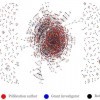Abstract
Social networks play an important role in the functioning of society and have an important effect on the actions of an individual or organization. It is very important for Extension educators to understand the networks of their clientele in order to perform better and develop more impactful Extension programming for their target audiences. This 5-page fact provides a brief description of network concepts and the terminology used in network studies, so that Extension educators may be more comfortable interpreting and using the results of SNA research to improve the efficiency and productivity of Extension organizations. Written by Anil Kumar Chaudhary and Laura A. Warner, and published by the UF Department of Agricultural Education and Communication, February 2015.
References
Bonacich, P. (2007). Some unique properties of eigenvector centrality. Social Networks, 29, 555-564. https://doi.org/10.1016/j.socnet.2007.04.002
Borgatti, S. P. (2005). Centrality and network flow. Social Networks, 27, 55-71. https://doi.org/10.1016/j.socnet.2004.11.008
Borgatti, S. P., Everett, M. G., & Johnson, J. C. (2013). Analyzing social networks. London: Sage Publications.
Brass, D. J., & Burkhardt, M. E. (1992). Centrality and power in organizations. Networks and organizations: Structure, Form, and Action, 191, 215-230.
Brass, D. J., Galaskiewicz, J., Greve, H. R., & Tsai, W. (2004). Taking stock of networks and organizations: A multilevel perspective. Academy of management journal, 47(6), 795-817. https://doi.org/10.5465/20159624
Burt, R. S. (1992). Structural Holes: The Social Structure of Competition. Cambridge, MA: Harvard University Press
Burt, R. S. (2000). The network structure of social capital. Research in Organizational Behavior, 22, 345-423. https://doi.org/10.1016/S0191-3085(00)22009-1
Freeman, L. C. (1979). Centrality in social networks conceptual clarification. Social Networks, 1(3), 215-239. https://doi.org/10.1016/0378-8733(78)90021-7
Gould, R. V., & Fernandez, R. M. (1989). Structures of mediation: A formal approach to brokerage in transaction networks. Sociological Methodology, 19, 89-126. https://doi.org/10.2307/270949
Granovetter, M. S. (1973). The strength of weak ties. American Journal of Sociology, 78(6), 1360-1380. https://doi.org/10.1086/225469
Kilduff, M., & Tsai, W. (2003). Social Networks and Organizations. Thousand Oaks, CA: Sage Publications. https://doi.org/10.4135/9781849209915
Kumar Chaudhary, A. (2014). Diversity and reach of Penn State Extension programs and effect of brokerage and network position on extension program outcomes through Social Network Analysis (SNA). (Unpublished master's thesis.) The Pennsylvania State University, State College, PA.
McCarty, C. & Vacca, R. (2013). A social network analysis of scientific collaborations at UF. PowerPoint slides.
Provan, K. G., Fish, A., & Sydow, J. (2007). Interorganizational networks at the network level: A review of the empirical literature on whole networks. Journal of Management, 33(3), 479-516. https://doi.org/10.1177/0149206307302554
Putnam, R. D., Leonardi, R., & Nanetti, R.Y. (1993). Making Democracy Work: Civic Traditions in Modern Italy. Princeton, NJ: Princeton University Press. https://doi.org/10.1515/9781400820740
Scott, J. (1988). Social network analysis. Sociology, 22(1), 109-127. https://doi.org/10.1177/0038038588022001007
Stevenson, W. B., & Greenberg, D. (2000). Agency and social networks: Strategies of action in a social structure of position, opposition, and opportunity. Administrative Science Quarterly, 45(4), 651-678. https://doi.org/10.2307/2667015
Stovel, K. & Shaw, L. (2013). Brokerage. Annual Review of Sociology, 38, 139-158. https://doi.org/10.1146/annurev-soc-081309-150054
Tsai, W. (2001). Knowledge transfer in intraorganizational networks: Effects of network position and absorptive capacity on business unit innovation and performance. Academy of Management Journal, 44(5), 996-1004. https://doi.org/10.2307/3069443
Vera, E. R., & Schupp, T. (2006). Network analysis in comparative social sciences. Comparative Education, 42(3), 405-429. https://doi.org/10.1080/03050060600876723
Wasserman, S., & Faust, K. (1994). Social Network Analysis: Methods and applications. Cambridge: Cambridge University Press. https://doi.org/10.1017/CBO9780511815478
Wellman, B., & Berkowitz, S. D. (Eds.). (1988). Social structures: A network approach. Cambridge: Cambridge University Press.
Yin, X., Wu, J., & Tsai, W. (2012). When Unconnected Others Connect: Does Degree of Brokerage Persist After the Formation of a Multipartner Alliance? Organization Science, 23(6), 1682-1699. https://doi.org/10.1287/orsc.1110.0711
Zack, M. H. (2000). Researching organizational systems using social network analysis. Proceedings of the 33rd Annual Hawaii International Conference on System Sciences. doi:10.1109/HICSS.2000.926933 https://doi.org/10.1109/HICSS.2000.926933

